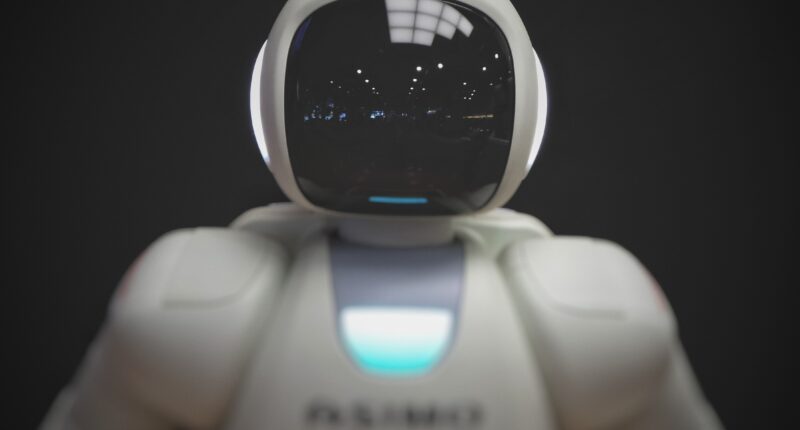A look at “Understanding Artificial Intelligence In The Workplace” Welcome to the future of work, where robots and humans share the same space in a collaborative effort to take on complex tasks. Artificial intelligence has been making waves in various fields, including healthcare, finance, and transportation. But what does it mean for the workplace? Will robots replace human workers or will they complement each other’s strengths? In this blog post, we’ll explore how artificial intelligence is revolutionizing jobs as we know them and how companies can prepare their workforce for this digital transformation. So buckle up and get ready to dive into the world of AI!

What is Artificial Intelligence?
In simple terms, Artificial Intelligence (AI) is the process of making a computer system “smart” – that is, able to understand complex tasks and carry out complex commands.
The term “Artificial Intelligence” was first coined in 1956 by Dartmouth professor John McCarthy, who defines it as “the science and engineering of making intelligent machines.”
AI systems are designed to learn and improve over time, usually through experience (a process known as machine learning). They can be programmed to perform very specific tasks, or they can be designed to be more general-purpose problem solvers.
There are different types of AI systems, but some of the most common are: rule-based systems, decision tree learning, artificial neural networks, genetic algorithms and evolutionary programming.
Benefits of AI in the Workplace
Artificial intelligence (AI) can provide many benefits for businesses, including the ability to automate tasks, improve decision making, and increase efficiency.
One of the most significant benefits of AI is its ability to automate tasks. This can free up employees’ time so that they can focus on more important tasks or projects. For example, if a business uses AI to automatically generate reports based on data collected, employees would no longer need to spend time doing this manually.
AI can also improve decision making by providing organizations with insights that they might not otherwise have access to. For example, by analyzing data sets, AI can help businesses identify patterns and relationships that they might not be able to see themselves. This can allow businesses to make better decisions about where to allocate resources or what products to develop.
Finally, AI can help businesses increase their efficiency by streamlining processes and reducing the need for human intervention. For example, if a business uses AI-powered chatbots to handle customer service inquiries, it would free up customer service representatives to handle more complex issues.
Overall, AI can provide substantial benefits for businesses in terms of automating tasks, improving decision making, and increasing efficiency.
Different Types of AI Applications in the Workplace
AI is being used more and more in the workplace as its capabilities continue to grow. Here are some different types of AI applications that are being used in businesses today:
1. Automated Customer Service: AI can be used to provide automated customer service, such as through chatbots. This can help to improve customer satisfaction by providing quick and accurate responses to common queries.
2. Improved Productivity: AI can be used to automate tasks that would otherwise need to be carried out by human employees. This can free up time for employees to focus on other tasks, and can improve overall productivity levels.
3. Smarter Business Decisions: AI can be used to analyze data and make predictions about future trends. This information can then be used by businesses to make better decisions about things like product development, marketing, and strategy.
4. Enhanced Security: AI can be used to monitor activity on corporate networks and identify potential security threats. This can help businesses to protect their data and systems from attack.
5. Improved Hiring Decisions: AI can be used to help businesses make better hiring decisions. It can analyze data from resumes and other sources to identify the best candidates for open positions, helping businesses to save time and money in the recruitment process.
How artificial intelligence is changing the workplace
The rise of artificial intelligence (AI) is transforming the workplace. As AI technologies become more advanced, they are increasingly being used to automate tasks and enhance decision-making. This has led to concerns about the future of work, with some people fearing that AI will lead to mass unemployment.
However, there is also much optimism about the potential of AI to improve productivity and create new jobs. In fact, many companies are already using AI in the workplace and reaping the benefits. Here are some ways in which AI is changing the workplace:
1. Automation of tasks: One of the most significant ways in which AI is changing the workplace is through automation. Tasks that are repetitive and well-defined are being increasingly automated using AI technologies such as robotics and machine learning. This frees up employees to focus on more creative and strategic work.
2. Improved decision-making: AI can also be used to enhance decision-making in the workplace. For instance, it can be used to analyze data and identify patterns that would otherwise be undetectable. This information can then be used to make better decisions about where to allocate resources or how to respond to market changes.
3. Creation of new jobs: While there is concern about job losses due to automation, it’s important to remember that AI will also create new jobs. For instance, businesses will need people to develop and manage AI systems, as well as to interpret the data they generate.
Overall, AI is transforming the workplace in many ways. It is automating tasks, improves decision-making, and creating new jobs. However, it’s important to keep in mind that this technology will require careful management and regulation in order to ensure that it does not lead to mass unemployment.
8 examples of artificial intelligence in the workplace
1. Job automation: Machines can now do many jobs that used to be done by humans, including data entry, customer service, and simple analysis. This can free up humans to do more creative or complex work.
2. predictive analytics: AI can analyze data much faster and more accurately than humans, allowing businesses to make better decisions about things like pricing, inventory, and risk management.
3. Marketing personalization: By analyzing customer data, AI can provide highly personalized recommendations and targeted ads, leading to increased sales and higher customer satisfaction.
4. Better decision making: AI can help managers make better decisions by providing them with real-time data and analysis that they wouldn’t have otherwise had access to.
5. Employee training and development: AI can be used to create custom training programs for employees based on their individual skills and needs. This leads to better employee development and retention.
6. Improved customer service: AI chatbots can handle basic customer service tasks like answering questions, taking orders, and providing support 24/7. This frees up human customer service reps to handle more complex issues.
7. Smarter products: AI can be used to create smarter products that are more efficient and user-friendly. For example, intelligent assistants like Siri and Alexa are powered by artificial intelligence.
8. Enhanced security: AI can be used to improve security by identifying patterns in data that humans would not be able to see. This allows businesses to prevent serious security breaches.
Regulations and Policies Regarding AI in the Workplace
When it comes to deploying AI in the workplace, organizations must be mindful of a number of potential regulatory and policy issues.
First and foremost, employers should ensure that their AI systems do not discriminate against employees or job applicants on the basis of protected characteristics such as race, gender, age, or disability. Additionally, employers should consider whether their AI systems may have a disparate impact on certain groups of individuals, and take steps to avoid or mitigate such impacts.
Organizations should also be aware of data privacy concerns when using AI in the workplace. For example, if an employer is using AI to monitor employee email or chat communications, they must comply with applicable data privacy laws and regulations. Similarly, if an employer is using AI to make decisions about employee hiring, promotion, or compensation, they must ensure that personal data is properly safeguarded and used only for legitimate business purposes.
Finally, employers should develop policies and procedures governing the use of AI in the workplace. These policies should address issues such as who has access to the organization’s AI system(s), how these systems are used and monitored, and what recourse employees have if they believe they have been adversely affected by an automated decision-making process.
Negative effects of artificial intelligence in the workplace
While there are many potential positive effects of artificial intelligence in the workplace, there are also a number of potential negative effects. These negative effects range from personal privacy concerns to more general worries about the impact of AI on the economy and job market.
One of the most commonly cited negative effects of AI is its impact on privacy. As AI increasingly collects and analyzes data, there are concerns that individuals’ personal data will be mishandled or simply become more accessible to those who would misuse it. This could lead to identity theft, fraud, or other malicious activity.
Another worry is that AI will lead to large-scale job loss as automation replaces human workers in a variety of industries. This could have a devastating effect on economies and social stability, as large numbers of people are left unemployed and without hope for the future. Additionally, it is possible thatAI will create new types of jobs that humans are not prepared for, further exacerbating inequality.
Finally, some believe that AI will ultimately lead to machine supersede human intelligence, creating a future in which machines control humanity instead of serving them. While this may seem like a far-fetched possibility, it is nonetheless a concern for many who are wary of artificial intelligence’s increasing power and presence in society.
Conclusion
Artificial Intelligence is here to stay and it will continue to impact the workplace in more ways than we can imagine. It’s important for us to understand how AI works, including its potential capabilities and limitations as well as the ethical considerations associated with its use. By understanding these aspects of AI, we can anticipate the future of our jobs and be better prepared for a world where robots are an integral part of our lives.
Continue to check our website for more articles of this kind. And, please use our comment section as well, we would love to hear from you.








